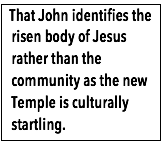Those
who follow the Church’s guidelines and apply historical-critical
methods in interpreting the Bible expect to discover more
than one layer of tradition in various texts.
In today’s
Gospel, the word “remembered” or “recalled” (see
Jn 2:17, 22) is a technical term used by John to describe
the process by which the community of believers gradually
came to view Jesus as the fulfillment of Scripture after
his resurrection.
Thus, Jn 2:17, 22 do not describe
on-the-spot responses of Jesus’ immediate followers but rather
the evangelist’s interpretation of the event more than sixty
years after the fact.
Prophetic Action
Jesus’ “cleansing of the Temple” is the obvious “historical” event
that John describes. All the evangelists report it, but the
Synoptics place it just prior to Jesus’ trial, making it the
more proximate cause of Jesus’ death. John locates it much
earlier in the ministry because he has made the raising of
Lazarus from the dead the more proximate cause of Jesus’ death.
Scholars think the Synoptic version is historically more likely.
 Granting that this is a historical event, how did Jesus’ contemporaries
perceive and interpret what he was doing and saying? Roman
denarii and Attic drachmas bore pagan or imperial portraits
and were unacceptable in paying the Temple tax (see Mt 17:27).
Moneychangers performed a necessary service by exchanging these
coins for acceptable coins of Tyre. Granting that this is a historical event, how did Jesus’ contemporaries
perceive and interpret what he was doing and saying? Roman
denarii and Attic drachmas bore pagan or imperial portraits
and were unacceptable in paying the Temple tax (see Mt 17:27).
Moneychangers performed a necessary service by exchanging these
coins for acceptable coins of Tyre.
Animals, too, were necessary for sacrifice, but it seems the
danger of an escaped animal entering the holy of holies was
a risk originally avoided by keeping them outside the Temple
precincts. It was likely Caiaphas who introduced them into
the Temple precincts.
If Jesus’ contemporaries perceived abuses or potential abuses
in these two activities, then Jesus the prophet is clearly
viewed as performing a “prophetic symbolic action” after
the fashion of Jeremiah (Jer 7:11) and Ezekiel. Such an action
actually sets in motion the judgment spoken by the prophet. “Stop
making the house of my Father a house of marketing!”
Body and Community
The second historical question in this scene concerns Jesus’
authority. “What sign can you show us for doing this?” This
is a legitimate concern for those responsible for proper Temple
behavior. Jesus’ answer, however, is totally unintelligible
in historical context. In fact it is absurd. “Destroy
this temple and in three days I will raise it up.” The
actual historical reconstruction of the Temple was begun by
Herod the Great around 20 B.C.E. and completed around 62 C.E.
Jesus’ original audience would have interpreted Jesus’ claim
symbolically, quite in line with his identity as a prophet
who is cleansing the Temple. For them, Jesus refers to a spiritual
or messianic renewal of the Temple and its function. Such a
hope continued even after the destruction of the Herodian Temple
and is echoed in the fourteenth of the Eighteen Benedictions
recited in the synagogue. This benediction combines the expectation
of a rebuilt Temple with the hope of a coming Messiah.
That John identifies the risen body of Jesus (Jn 2:21) rather
than the community as the new Temple is culturally startling.
From a purely Mediterranean cultural perspective, this individualistic
interpretation could be the consequence of his group’s distrust
of all other groups.
From a faith perspective, John says it all came clear after
the resurrection (Jn 2:22). How do culture and faith (understood
as loyalty) relate to each other?
John J. Pilch
|
John
J. Pilch is a biblical scholar and
facilitator of parish renewals.
Liturgical Press has published
fourteen books by Pilch exploring the
“cultural world” of the Bible.
Go to http://www.litpress.org/ to
find out more.
Copyright © 1997 by The Order of St.
Benedict, Inc., Collegeville, MN.
All rights reserved.
Used by permission from The
Liturgical Press, Collegeville,
Minnesota 56321
The complete text of the
above article can be found in:
The Cultural World of Jesus, Sunday by Sunday, Cycle B
John J. Pilch. The Liturgical Press. 1996. pp. 55-57.
Art by
Martin Erspamer, O.S.B.
from Religious Clip Art for the
Liturgical Year (A, B, and C).
Used by permission of Liturgy Training
Publications. This art may be reproduced
only by parishes who purchase the
collection in book or CD-ROM form. For
more information go to: http://www.ltp.org/
|
|